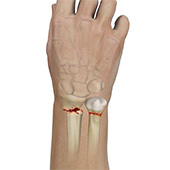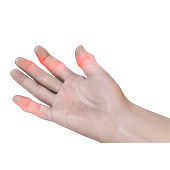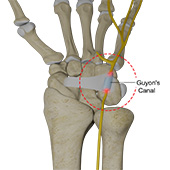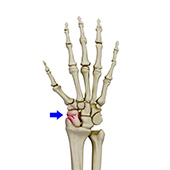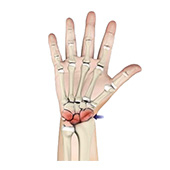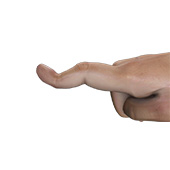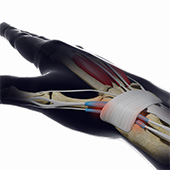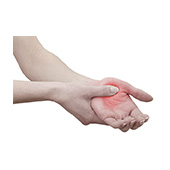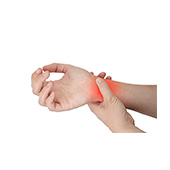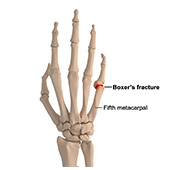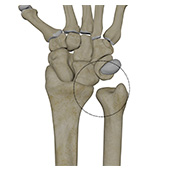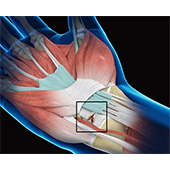- Anatomy
- Conditions
- Procedures
Wrist Fracture
The wrist is comprised of two bones in the forearm, the radius and ulna, and eight tiny carpal bones in the palm. The bones meet to form multiple large and small joints. A wrist fracture refers to a break in one or more of these bones.
Finger Sprain
Injuries that involve tearing or stretching of the ligaments of your fingers are termed as sprains. Sprains in the fingers are most often caused from a fall when you extend your arms to reduce the impact of the fall, or from overuse or repetitive activity of the thumb such as with texting.
Ulnar Nerve Compression in Guyon's Canal
Ulnar nerve compression in Guyon’s canal is a condition characterized by pain, numbness, weakness, and tingling sensation in the hand. The condition occurs when the ulnar nerve, the nerve that travels across the elbow from the shoulder to the hand, is compressed as it goes from the wrist into the hand through a space known as Guyon’s canal. Ulnar nerve damage stops or slows down signals that are being sent across the nerve to the hand.
Scaphoid Fracture
The scaphoid bone is a small, boat-shaped bone in the wrist, which, along with 7 other bones, forms the wrist joint. It is present on the thumb side of the wrist and is at high risk for fractures. A scaphoid fracture is usually seen in young men aged 20 to 30 years. They can occur at two places: near the thumb or near the forearm.
Arthritis of the Hand and Wrist
Arthritis is an inflammatory condition of the joints. There are several types of arthritis and the most common type is osteoarthritis or wear-and-tear arthritis. Arthritis affects various joints in the body and the arthritis in the hand affects the joint at the base of the thumb. Arthritis may also affect the joints of other digits.
Boutonniere Deformity
Tendons in your fingers connect the finger bones to finger muscles and help bend and straighten the finger at the joint when the muscles contract. Boutonnière deformity is a condition in which a tendon injury to the middle joint of the finger results in the inability to straighten the affected finger.
Carpal Tunnel Syndrome
Carpal tunnel syndrome is a common, painful, progressive condition that is caused by compression of the median nerve at the wrist area.
De Quervain's Tendinosis
Inflammation and swelling of the tendon sheaths put pressure on the adjacent nerves and leads to pain and numbness in the thumb side of the wrist. Strain on these tendons can cause swelling and irritation, and lead to a condition called De Quervain's tenosynovitis, which is characterized by inflammation. The condition is also referred to as De Quervain’s tendinitis, De Quervain’s tendinosis, De Quervain’s syndrome or De Quervain’s disease.
Trigger Finger
Inflammation in the tenosynovium leads to a condition called trigger finger, also known as stenosing tenosynovitis or flexor tendonitis, where one of the fingers or thumb of the hand is caught in a bent position. The affected digit may straighten with a quick snap, like pulling and releasing the trigger on a gun, hence the name trigger finger.
Hand Pain
The hand is composed of nerves, bones, blood vessels, muscles, tendons and skin. Each part has its specific function such as nerves transfer sensation, joints control movements, blood vessels maintain circulation, muscles provide motion, tendons anchor the muscles to the bones, and skin receives sensations.
Wrist Injuries
The wrist is a commonly injured joint in the body. Problems include sprains and strains as well as fractures that can occur with lifting and carrying heavy objects, while operating machinery, bracing against a fall, or from sports-related injuries.
Boxer's Fracture
A boxer’s fracture is a break in the neck of the fifth metacarpal bone of the hand (below the pinky finger) close to the knuckle. The hand is composed of 3 types of bones: carpal or wrist bones, metacarpals or long hand bones, and phalanges or finger bones. Metacarpals consist of five long bones that connect the carpal with the phalanges. Structurally, metacarpal bones can be divided into four parts: base, shaft, neck, and head. In some cases, the broken bone can protrude through the skin and is called an open fracture.
Wrist Pain
Wrist pain is defined as any ache or discomfort in the wrist. The wrist is comprised of two bones in the forearm, the radius and ulna, and eight tiny carpal bones in the palm. The bones meet to form multiple large and small joints. A trauma or injury to one or more of these bones results in wrist pain.
Distal Radioulnar Joint (DRUJ) Instability
Distal radioulnar joint instability is the abnormal orientation or movement of the radius and ulna bones at the wrist in relation to one another. Injury to the tendons, ligaments and/or muscles stabilizing the joint may cause partial or complete dislocation.
Wrist Ligament Tear and Instability
A ligament is a strong, flexible band of fibrous tissue. The wrist has many ligaments that help to keep the wrist bones in proper position providing stability to the joint. A torn ligament causes the wrist bones to move out of their position, which in turn leads to wrist instability as the sprained (torn) ligament can no longer support the wrist bones.

